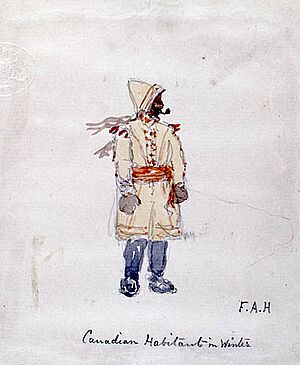Habitants facts for kids

Habitants were early French settlers in what is now Quebec, Canada. They were farmers who lived along the St. Lawrence River and its Gulf. People used the term "Habitant" from the 1600s until the early 1900s. After that, people started using words like agriculteur (farmer) instead.
Habitants in New France got land from a seigneur (a landowner, like a lord). They had to clear the land within a certain time or lose it. This rule stopped the seigneur from selling the land. Instead, they gave it to farmers, the habitants. When a habitant received land, they agreed to pay yearly fees and follow some rules.
Rent was the most important payment. It could be paid with money, crops, or work. Once the rent was set, it stayed the same. Habitants were mostly free to farm their land as they wished. They only had a few duties to their seigneur.
Seigneurs also had duties to their habitants. A seigneur had to build a gristmill (a mill for grinding grain) for the farmers. In return, habitants had to grind their grain there. They gave the seigneur one sack of flour for every 14 sacks they ground. Seigneurs could also ask for a few days of forced work from the habitants. They also had rights over fishing, timber, and shared pastures.
Even though seigneurs asked for more at the end of French rule, they never got super rich from these payments. Habitants were free people. Seigneurs only owned certain rights over the land and its activities. The relationship between a seigneur and a habitant meant they both shared ownership of the land.
Life as a Habitant
Most habitants grew crops mainly for their own families. They used what they grew for food and clothing. This way of life is called a subsistence economy. They farmed this way because there wasn't a huge market to sell their crops in Quebec.
Many people in New France and early Quebec were farmers. Around 70% of Quebec's people were farmers in 1851. This meant that Quebec farmers mostly sold their goods to people within Quebec. Because of this smaller market, habitants usually didn't have a lot of extra money.
Payments and Duties
Getting land from a seigneur came with certain duties. First, habitants had to farm the land and live on it. If they didn't farm it within a year, the seigneur could take it back. This was called the "droit de réunion."
Habitants also paid several fees to the seigneur:
- Cens: This was a small, symbolic payment, usually 2 to 6 sols.
- Rent: This was usually 20 sols for every "arpent" (a measure of land). This was a bigger cost each year.
- Other fees: Habitants paid for things like letting their animals graze in common fields or cutting wood.
- Lods et ventes: If a habitant sold their land, they paid the seigneur one-twelfth of the sale price.
- Mill fee: They had to grind their wheat at the seigneur's mill. They paid one-fourteenth of the ground wheat as a fee.
- Fishing fee: Some habitants also gave the seigneur one-thirteenth of the fish they caught.
- Corvées: Some habitants had to do 1 to 4 days of mandatory work. This usually happened during planting, harvesting, or haying season.
Habitants fulfilled these duties to thank the seigneur for giving them land.
Family and Community
Habitants moved to New France hoping for a better life. They wanted more farming opportunities and larger land plots. They could then pass these lands down to their children.
For women, much of their adult life was spent as a wife and raising children. Marriage was very important. Widows often remarried quickly. Because there were more men than women, women often had many choices for a husband. Arranged marriages were not common. Some women, called Filles du Roi, were even paid by the King of France to move to New France and help the population grow.
The church was a big part of a habitant's life. The local parish church recorded all births, marriages, and deaths. These important life events were religious traditions with special rituals. Churches and rectories (priests' homes) were also used as meeting places and community halls. Sometimes, emergency food was stored in church attics. Sunday Mass was not just for worship; it was also a time for the community to gather and socialize.
See also


